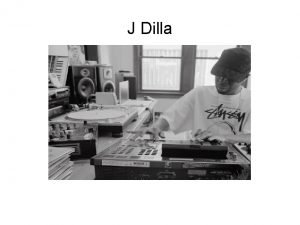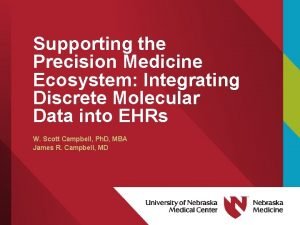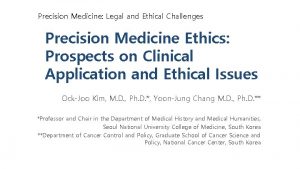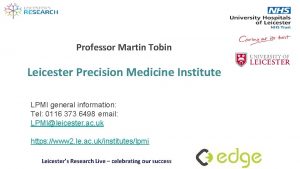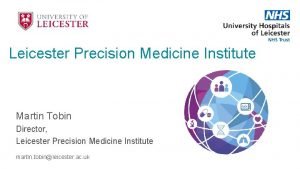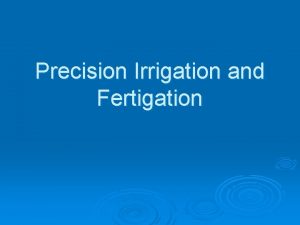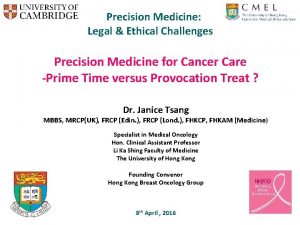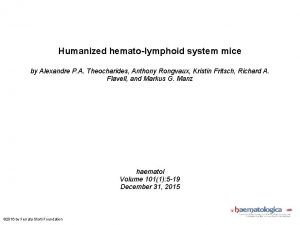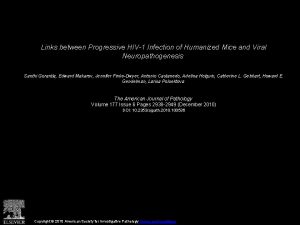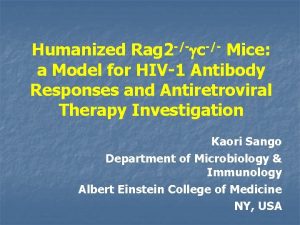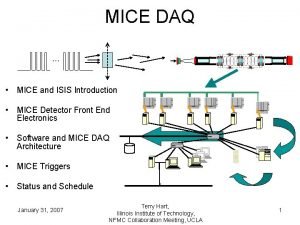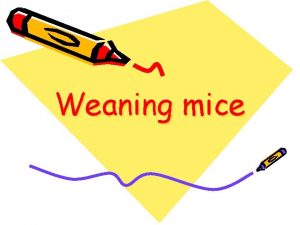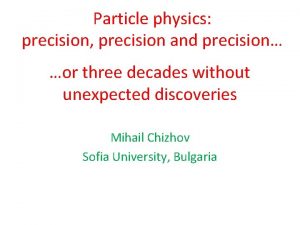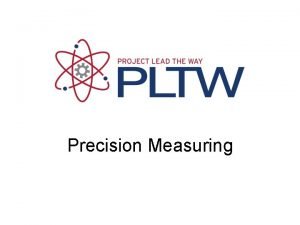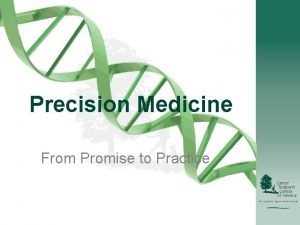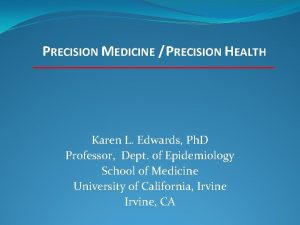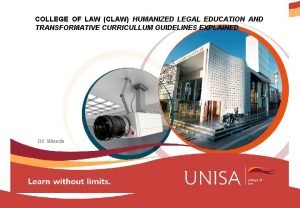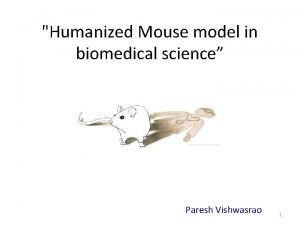Application of humanized immunodeficient mice for precision medicine


































- Slides: 34

Application of humanized immunodeficient mice for precision medicine 擬人化免疫缺陷小鼠在精準醫學的應用 Shu-Wha Lin, Ph. D. 林淑華 台大醫技系 Professor, Department of Clinical Laboratory Science and Medical Biotechnology, College of Medicine, National Taiwan University Principal Investigator of Transgenic Mouse Model Core (TMMC) Facility Ministry of Science and Technology, Taiwan 1

Precision oncology Determine tumor-driving networks that function in a particular patient’s tumor Design a rational combination therapy Test in vitro/in vivo Apply treatment on patient 2 Nat Rev Clin Oncol. 2014 Feb; 11(2): 109 -18.

PDX (patient derived xenograft) an ideal in-vivo model for preclinical testing


NOD-scid IL 2 rγ • • • 5 null • (NSG) mice Lack of mature T, B, and functional NK cells Deficient in signaling of multiple cytokines (IL 2, IL 4, IL 7, IL 9, IL 15 and IL 21) Engraftment of human tissues, HSC, and PBMC: Significantly improved Resistant to lymphoma, allowing for long-term experiments Application: - Reconstitution of human immune systems (hu-PBL/HSC mice) - Patient-derived xenograft (PDX) NOD. Cg-Prkdcscid Il 2 rgtm 1 Wjl/Sz. J JAX Lab (Ito, Takahashi et al. 2012 Cell Mol Immunol. 208 -14)

WHY NSG? • Patient Tumor Characteristics NSG™ vs scid Cancer Patient’s Lung Tumor Fragment NSG™ H&E C. B-17 scid H&E Human cells (anti-HLA) Mouse blood cells (anti-m. CD 45) Simpson-Abelson MR et al. 2008. J Immunol 180(10): 7009 -18. PMID: 18453623 JAX® Mice | 18

Hu-PDX Humanized tumor-bearing NSGTM Engraftment of human tumor in mice with human immune system The next step in cancer modeling NOD. Cg-Prkdcscid Il 2 rgtm 1 Wjl/Sz. J (NSGTM) (005557) In Vivo Pharmacology Services | 48

WHY Hu-PDX ? Tumor in humanized PDX NSG v. s Tumor in PDX NSG Genetic drift in tumor cells PDX Hu-PDX Disease Models & Mechanisms 1, 78 -82 (2008) doi: 10. 1242/dmm. 000976

WHY Hu-PDX ? 免疫療法仰賴病人自身免疫細胞攻擊癌細胞 以 humanized PDX mouse model 測試療效 • More faster and robust reconstitution of human immune system (CD 34 + HSC) + l 4 weeks, majority CD 33 myeloid cells, Tregs Human PDX breast tumor Human PDX lung tumor Testing the response of patient’s tumor to immune check point inhibitors can be possible 以anti-PD-1抗體治療 Pembrolizumab (Keytruda): anti-PD-1 antibody Ipilimumab (Yervoy): anti-CTLA 4 antibidy 以anti-PD-1抗體治療 以anti-CTLA 4抗體治療 9 JAX Lab


Our efforts on humanized mouse models 11


建立測試移植人類免疫系統的擬人化小鼠平台 patient 周邊血 移植成功定義 h. CD 45+ cells > 15% T, B cells 功能測試 Human PBMC Humanized Hemophilia NSG mice 功能測試 13

建立測試移植人類免疫系統的擬人化小鼠平台 利用病人周邊血移植入經CRISPR改造的NSG血友病小鼠 patient Inhibitor (+) 周邊血 Human PBMC Humanized Hemophilia NSG mice 移植成功定義 h. CD 45+ cells > 15% T, B cells 功能測試 Ig. G titer (與病人相當) 功能測試 Presence of Treg細胞 (Antigen challenge) 14

Who we are and our achievement Prof. Shu-Wha Lin ØP. I. ---National Transgenic Mouse Model Core facility Ministry of Science and Technology, TAIWAN http: //140. 112. 133. 74/ The core facility has generated > 400 KO/KI mice; helped our user to win a technology transfer to Novo Nordisk for USD$13 millions 15

Hemophilia A-NSG mice deletions in exon 1 of the FVIII gene results gender # of Mice Genotyping available Male 12 9 4 5 Female 8 8 4 4 Total 20 17 8 9 WT Indel 16

3 rd generation Hemophilia A NSG mice were crossed with NSG mice to more than three generation to eliminate potential off-targets Genotyping 17

• hemophilia A-NSG mice showed reduced m. RNA levels and clotting activities • Liver FVIII m. RNA level (quantitative RT-PCR):> 50% decrease • FVIII activity (APTT): greatly reduced, comparable to that detected in the widely-used Hemo. A mice (B 6; 129 S-F 8 tm 1 Kaz/J) (B 6/129) 18


Setup hu-NSG mouse model Engraftment of PBMC from healthy donor into NSG mice (1): Injection route Healthy donor h. PBMC engraftment Weekly Flow cytometry for proportion of h. CD 45+ cell Successful engraftment h. CD 45+/m. CD 45+ > 15% in mice Humanized mice 20 Successful engraftment rates intravenous injection (I. V. ) 58% (14/24) intrafemoral (I. F. ) 100% (n=8) intrasplenic injection (I. Sp. ) 90~100% (n=10)

Engraftment of PBMC from healthy donor into NSG mice (2): Time for reconstitution of human immune system I. V. (A) & I. F. (B) 4 th~5 th weeks I. Sp. (C) 2 nd ~3 rd weeks 21

Engraftment of PBMC from healthy donor into NSG mice (3): Proportion of human T and B cells in mouse PB B cells detected in mice by Intra-splenic & intrafemoral injection

Engraftment of PBMC from healthy donor into NSG mice (4): Detection of human total Ig. G

Study with patients’ samples

hu-NSG model: PBMC from Hemo A patients into NSG mice Density gradient separation 2. 1 x 106 Viable cells #4 patient Data provided by Dong-Yan Tsai, in Dr. 林國儀’s Lab Anti-CD 19 beads plasmablasts Rest of the cells Intra-femoral injection CD 45+ Intra-splenic injection 25

B cells and plasma cells in Hu-PBL NSG mice Mouse #1

Hu-NSG hemophilia mice human T & B cells in the bone marrow and spleen Bone marrow Spleen B: 2 -10% B: 1 -20% Human B cell : h. CD 45+h. CD 19+ 27

Immunization of hu-PBL mice with antigen Intra-splenic injection Spleen B cells Human cytokine AAV: Blys, IL-4, GMCSF Treg Hemo A NSG Immunization Treg B cells Treg

High titer Ag-specific antibody in Hu-PBL NSG mice h. HA-NSG#1 總抗體效價 (anti-FVIII Ig. G) 中和性抗體效價 h. HA-NSG#2 病例: 4號病人 (50歲, 未曾接受ITI) 抗體效價 123 BU (2016. 06) 總抗體效價 (anti-FVIII Ig. G) 中和性抗體效價 29

Re-engraftment (繼代移植) h. PBMC engraftment Inhibitor+ patient Primary recipient Hemo. A-NSG mice h. PBMC engraftment GVHD (weight loss >15%) 2 nd recipient Hemo. A-NSG mice 3 rd recipient Hemo. A-NSG mice 30

Stable engraftment of human Immune system into NSG mice 病例: 4號病人 (50歲, 未曾接受ITI) 抗體效價 123 BU (2016. 06) Primary recipient mice 每天輸注高劑量第八因 子蛋白 h. HA-NSG#5 繼代移植 2 nd recipient mice 每天輸注高劑量第八因子 蛋白 31

Conclusion Humanized NSG mice Platform has been established p rate of successful engraftment ~100% (> 30 mice tested) p p route of transplantation is important Majority T cells with detectable B cells and Treg cells p Antigen specific Ig. G (inhibitors) is detectable, i. e. , functional immune response p Will set up hu-NSG by repopulating mice with peripheral CD 34+ cells p 32


Challenges limiting the utility of HM model Cancer Res. 2016 Nov 1; 76(21): 6153 -6158.
 How j dilla humanized his mpc3000
How j dilla humanized his mpc3000 Single precision vs double precision
Single precision vs double precision Linear measure and precision
Linear measure and precision Precision vs semi precision attachment
Precision vs semi precision attachment Precision medicine ecosystem
Precision medicine ecosystem Ethical issues in precision medicine
Ethical issues in precision medicine Martin tobin leicester
Martin tobin leicester Dr martin tobin
Dr martin tobin Low energy precision application
Low energy precision application Rådet för byggkompetens
Rådet för byggkompetens Lufttryck formel
Lufttryck formel Vad är densitet
Vad är densitet Elektronik för barn
Elektronik för barn Tack för att ni har lyssnat
Tack för att ni har lyssnat Smärtskolan kunskap för livet
Smärtskolan kunskap för livet Jiddisch
Jiddisch Novell typiska drag
Novell typiska drag Luftstrupen för medicinare
Luftstrupen för medicinare Frgar
Frgar Autokratiskt ledarskap
Autokratiskt ledarskap Matte större än tecken
Matte större än tecken Adressändring ideell förening
Adressändring ideell förening Toppslätskivling effekt
Toppslätskivling effekt Redogör för vad psykologi är
Redogör för vad psykologi är Borra hål för knoppar
Borra hål för knoppar En lathund för arbete med kontinuitetshantering
En lathund för arbete med kontinuitetshantering Mat för idrottare
Mat för idrottare Geometri för barn
Geometri för barn Bris för vuxna
Bris för vuxna Ledarskapsteorier
Ledarskapsteorier Offentlig förvaltning
Offentlig förvaltning Antikt plagg
Antikt plagg Humanitr
Humanitr Datorkunskap för nybörjare
Datorkunskap för nybörjare Rita perspektiv
Rita perspektiv
